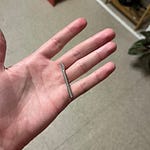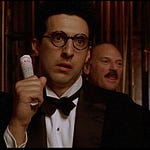J.G. Ballard’s seminal novel—on which the 1996 David Cronenberg joint1 is based—is about people who get off on car crashes.
Protagonist James Ballard (who shares a name with the author) is inducted into this deathstyle by Dr. Robert Vaughan, a “nightmare angel of the expressways” driven by the ultimate fantasy of a head-on collision with Elizabeth Taylor2. Reckless as tornado hunters, Vaughan and his acolytes roam the highways around what’s now Heathrow Airport in search of accidents and their survivors, all brutalized, disabled, and, if they’re anything like them, newly ravenous for exciting new traumas. As James discovers, these fire-and-metal baptisms—catalytic converters, if you will—produce new relationships to his own and others’ bodies, as well as to the “trap[s] of gas and metal knives” where they fuck.
While nominally straight, James begins having sex with Vaughan, using these erotic experiences to fuel other ones. In one scene, he describes an encounter with Vaughan to arouse his wife, Catherine.
My description of Vaughan continued more for Catherine’s benefit than for my own. She pressed her head deep into the pillow, right hand in a fierce dance as she forced my fingers to manipulate her nipple. Although stirred by the idea of intercourse with Vaughan, it seemed to me that I was describing a sex act involving someone other than myself. Vaughan excited some latent homosexual impulse only within the cabin of his car or driving along the highway. His attraction lay not so much in a complex of familiar anatomical triggers - a curve of exposed breast, the soft cushion of a buttock, the hair-lined arch of a damp perineum - but in the stylization of posture achieved between Vaughan and the car. Detached from his automobile, particularly in his own emblem-filled highway cruiser, Vaughan ceased to hold any interest.
James’s queerness is specific but not incidental. Prior to the crash that transformed his sex drive, his desire for Catherine, and hers for him, was cold as Plexiglass. With their shared fetish, James, Vaughan, Catherine, and their lovers create space for new desires, not to mention excretions, sensations, and crises.
Viewed in the normative way, the fetish is limiting; the fetishist can’t have normal sexuality and instead is doomed to chase the deviant object of desire (though as we say here on DAVID, sometimes a foot is just a foot). But as an alternative to the equally limiting—and, arguably, dangerous, depending on who you are—heterosexuality from which Ballard’s characters have been wrested, it’s broadening the field of pleasure, not shrinking it. While rehabilitating from the injuries of his own crash, James discovers in exam rooms and x-ray machines that while cars claim his heart and cock, there’s endless pleasure to be found beyond the heterosexed human body. Among alien “[mazes] of electronic machinery” are “languages of invisible eroticisms” and “undiscovered sexual acts” for the roving eye of subjectivity to witness.
I’ve been thinking a lot about social contagion, and, surprising no one, I’ve found myself returning to the pervert maestros of body horror to think my way through it. Right now, some trans people are critiquing our knee-jerk response to the idea that being trans is contagious (derogatory. Paging Susan Sontag!). On this subject, I’m in agreement with P.E. Moskowitz, who tweeted recently that “ofc transness is socially spread!!!! there’s no set number of people who are trans!!! we must be comfortable with the idea that many more people WANT to be trans. and that’s good!!! stop with ur born this way bullshit!!!”
I enjoy thinking about the trans people who made me want to be trans. Some of them I wanted to look and be like, like the first transmasculine person I ever spoke to. Some of them, like Morgan M Page, were trans in a different way but had created transsexual lifestyles and communities that I desperately wanted for myself, that were familial, political, glamorous, intellectual, sexy, defiant, and brave. Whether encountered interpersonally or otherwise, these trans people are why I am the way I am—which is to say, alive.
They’re not the whole picture. Pretending that my social contagion of transness begins and ends with trans people would require pretending that they’re the limits of my social existence. Yet cis people have comprised the vast majority of my human relationships, especially the formative ones. Within the confines of cisnormativity, this has been traumatizing in ways I will never be able to fully express. In thinking about my cis influences, the word salvage comes up frequently—true to queer form, I’ve taken a great deal from straight culture3 that wasn’t meant for me.
But what about the cis people who saw my transness, who nurtured, supported, desired, fetishized, or welcomed it? If being trans is contagious, it’s not impossible that a cis person was my Patient Zero.
Find me on Twitter. Preorder my second novel, X (Catapult, 2022), out June 28. I have events and everything!
Book Passage Pride Reading with Gretchen Felker-Martin: Thursday, June 23, virtual.
The Strand Book Launch with Torrey Peters: Tuesday, June 28, in person.
Subscribe to support GOOD ADVICE/BAD GAY, an advice series from an anonymous gay therapist who’s not afraid to hurt your feelings with the truth. (Sample an unlocked post for a taste of what you’re missing.) 100% of funds go to support a rotating selection of mutual aid and reparations projects.
Want advice? Email badgayadvice@gmail.com for a free 3-month subscription.
Reminder that I occasionally, I use cis and straight interchangeably. This is never done by mistake.













